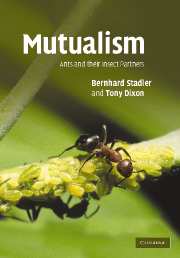7 - Prospects and conclusions
Published online by Cambridge University Press: 13 August 2009
Summary
Historically, ecology has been dominated by research on negative (antagonistic) interspecific interactions like competition and predation/parasitism. Nevertheless, this bias has led to a good understanding of the population dynamics of many species and organization of communities. In particular, the development of the theory of host–parasitoid and predator–prey dynamics was associated with experimental studies searching for mechanisms and general rules in population ecology. The advantage of studying negative interactions is that the fitness of the victim is likely to be zero, or close to zero, if eaten or parasitized. This makes it easier to track the outcome of these interactions both theoretically and experimentally. In addition, the idea of regulation is very seductive as it suggests clear relationships between predators and prey or between hosts and parasites and a simple mechanism generating population fluctuations. Mutualism, in contrast, involves reciprocal positive interactions between organisms belonging to different species and often produces less clear cut outcomes. Positive interactions tend to be diffuse, dependent on boundary conditions and thus may shift from positive to negative over time. This means that a good understanding of the conditions is necessary for quantifying the net outcome of conditional interactions. In spite of these difficulties, there is growing evidence that at least temporal positive interactions are widespread in insect communities and, in particular, between ants and their insect partners.
- Type
- Chapter
- Information
- MutualismAnts and their Insect Partners, pp. 175 - 183Publisher: Cambridge University PressPrint publication year: 2008



